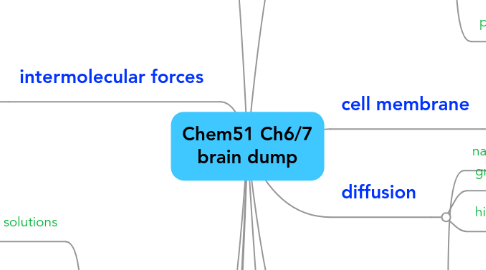
1. lipids
1.1. nonpolar
1.2. fatty acids + glycerol = glycerides
1.2.1. monoglycerides
1.2.1.1. glycerol backbone and 1 fatty acid
1.2.2. diglycerides
1.2.2.1. glycerol backbone and 2 fatty acids
1.2.3. triglycerides
1.2.3.1. glycerol backbone and 3 fatty acids
1.2.4. glycerophospholipids
1.2.4.1. glycerol + fatty acids + phosphate + ....
1.3. dissolve only in nonpolar solvents
1.4. hydrophobic
2. intermolecular forces
2.1. London forces
2.1.1. only IMF for nonpolar molecules
2.1.2. weakest IMF, but if a lot of London forces act together, can be very strong
2.1.3. also called dispersion forces
2.1.4. also called induced dipole
2.1.4.1. temporary dipole induced by an ion or other force
2.1.4.2. temporary charge on one molecule induces dipole in its neighbor
2.1.5. temporary dipoles
2.1.5.1. due to shifting electron configuration
2.1.5.2. happens as molecules move around
2.2. dipole-dipole
2.2.1. permament dipoles on polar molecules
2.2.2. stronger IMF
2.2.3. partial positive and partial negative charges
2.2.4. polar molecules like water, etc.
2.3. hydrogen bonding
2.3.1. special kind of very strong dipole-dipole
2.3.2. hydrogen bond donor
2.3.2.1. H covalently bonded to N, O, F
2.3.2.2. N, O, F very electronegative draw electrons towards them creates strong partial positive on covalently bonded H
2.3.3. hydrogen bond acceptor
2.3.3.1. N, O, F with lone pair(s)
2.3.3.2. lone pairs strong partial negative charge that attract the partial positive H
2.4. ion-dipole
2.4.1. interaction between ions with formal charge and dipoles with partial charges
2.5. also called van der Waals
3. mixtures
3.1. solutions
3.1.1. homogenous
3.1.2. clear
3.1.3. solute of very small particles
3.2. colloids
3.2.1. homogenous
3.2.2. cloudy
3.2.3. scatters light
3.2.4. solute of small particles
3.2.5. won't settle
3.2.6. can't be filtered
3.3. suspensions
3.3.1. larger particles
3.3.2. solute can be filtered
3.3.3. will settle after a while
4. esterification
4.1. reactions
4.1.1. hydrolysis
4.1.2. condensation
5. miscellaneous
5.1. 1 g / 1 mL for water
5.2. serial dilutions
6. solutions
6.1. concentration
6.1.1. ppm
6.1.2. ppb
6.1.3. molarity
6.1.4. Equivalents
6.1.5. percent
6.1.5.1. by weight
6.1.5.2. by volume
6.2. dilution
6.2.1. ci x vi = cf x vf
6.3. solubility
6.3.1. like dissolves like
6.3.2. similarity of IMF determins solubility
6.4. solvation
6.4.1. molecules of solvent surrounding solute
6.5. hydration
6.5.1. molecules of water surrounding solute atoms, ions or molecules
6.6. phase
6.6.1. solid in liquid
6.6.2. liquid in liquid
6.6.3. gas in liquid
6.6.4. solid in solid
6.6.5. liquid in liquid
6.6.6. gas in gas
6.6.7. Untitled
7. cell membrane
7.1. transport
7.1.1. diffusion
7.1.2. active transport
7.1.3. passive transport
7.2. proteins
7.3. phospholipid bilayer
7.4. channels
7.5. carbohydrates
8. diffusion
8.1. greater concentration to lower concentration
8.2. higher partial pressure to lower partial pressue
9. osmosis
9.1. naked egg experiment
9.1.1. semipermeable membrane
9.1.2. crenate
9.1.2.1. crenation
9.1.2.2. deflate or shrink due to loss of water
9.1.3. lyse
9.1.3.1. lysis
9.1.3.2. swells or bursts due to too much water
9.2. hypotonic
9.2.1. less concentrated in comparison
9.2.2. cell in hypotonic solution will lyse or burst
9.2.3. water will flow from hypotonic solution (more water) into cell (less water)
9.3. hypertonic
9.3.1. more concentrated in comparison
9.3.2. cell in hypertonic solution will crenate or deflate
9.3.3. water will flow out of cell (more water) to the solution (less water)
9.4. isotonic
9.4.1. same concentration
9.4.2. no change in cell in an isotonic solution
9.4.3. need to keep our bodily fluids isotonic with blood to avoid damage by lysis or crenation
9.4.4. isotonic fluid replacement solutions
9.4.4.1. Dextrose 5%
9.4.4.2. saline 0.90%
9.4.4.3. Untitled
10. IMF and phase change
10.1. boiling point
10.1.1. molar mass
10.1.2. kinds of intermolecular forces
10.2. disruptive forces vs attractive forces
10.3. heat of reaction
10.3.1. exothermic
10.3.2. endothermic
